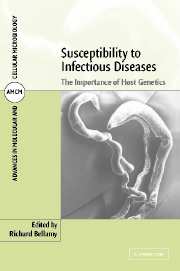Book contents
- Frontmatter
- Contents
- Contributors
- 1 Introduction
- 2 Application of genetic epidemiology to dissecting host susceptibility/resistance to infection illustrated with the study of common mycobacterial infections
- 3 The diverse genetic basis of immunodeficiencies
- 4 Genetic diversity in the major histocompatibility complex and the immune response to infectious diseases
- 5 The cystic fibrosis transmembrane conductance regulator
- 6 The influence of inherited traits on malaria infection
- 7 Polymorphic chemokine receptor and ligand genes in HIV infection
- 8 NRAMP 1 and resistance to intracellular pathogens
- 9 The interleukin-12/interferon-γ loop is required for protective immunity to experimental and natural infections by Mycobacterium
- 10 Mannose-binding lectin deficiency and susceptibility to infectious disease
- 11 Blood group phenotypes and infectious diseases
- 12 Genetics of human susceptibility to infection and hepatic disease caused by schistosomes
- 13 Genetic susceptibility to prion diseases
- Index
- Plate section
8 - NRAMP 1 and resistance to intracellular pathogens
Published online by Cambridge University Press: 14 August 2009
- Frontmatter
- Contents
- Contributors
- 1 Introduction
- 2 Application of genetic epidemiology to dissecting host susceptibility/resistance to infection illustrated with the study of common mycobacterial infections
- 3 The diverse genetic basis of immunodeficiencies
- 4 Genetic diversity in the major histocompatibility complex and the immune response to infectious diseases
- 5 The cystic fibrosis transmembrane conductance regulator
- 6 The influence of inherited traits on malaria infection
- 7 Polymorphic chemokine receptor and ligand genes in HIV infection
- 8 NRAMP 1 and resistance to intracellular pathogens
- 9 The interleukin-12/interferon-γ loop is required for protective immunity to experimental and natural infections by Mycobacterium
- 10 Mannose-binding lectin deficiency and susceptibility to infectious disease
- 11 Blood group phenotypes and infectious diseases
- 12 Genetics of human susceptibility to infection and hepatic disease caused by schistosomes
- 13 Genetic susceptibility to prion diseases
- Index
- Plate section
Summary
INTRODUCTION
The role of genetic factors in predisposition to infectious diseases has long been recognised in humans (reviewed by Cooke and Hill, 2001), and some infections such as tuberculosis and leprosy were long believed to be inheritable diseases. One of the clearest examples of the effect of the host genetic makeup on susceptibility to infection in humans is malaria (Kwiatkowski, 2000; Fortin et al., 2002), where the blood-borne parasite itself may have exerted a positive selective pressure for the retention of otherwise disease-associated alterations in certain erythrocyte proteins. Indeed, in sickle-cell anemia, heterozygosity for mutant hemoglobin alleles confers survival advantage over homozygosity for either mutant or wild-type alleles (Pasvol et al., 1978; Hill et al., 1991; Shear et al., 1993). On the other hand, functional polymorphisms affecting transcriptional control of key host response genes such as tumour necrosis factor-α (TNF-α) have been shown to drastically affect disease progression and outcome (McGuire et al., 1994). However, in most serious infectious diseases, the molecular identification of the genetic component of susceptibility has remained an extremely difficult task with few successes. Indeed, reduced penetrance, variable expressivity, a wide disease spectrum associated with variations in microbe-encoded virulence determinants, together with poor diagnostic criteria make it very difficult to decipher and map single gene effects, even if major, in human populations.
- Type
- Chapter
- Information
- Susceptibility to Infectious DiseasesThe Importance of Host Genetics, pp. 221 - 258Publisher: Cambridge University PressPrint publication year: 2003
- 2
- Cited by



